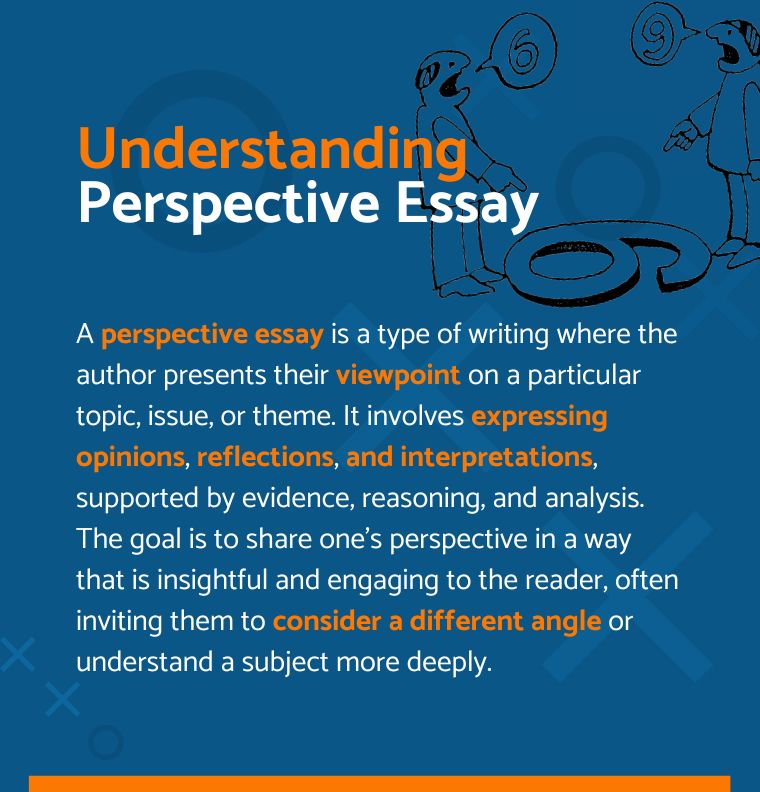How to Write Perspective Essay
Table of contents
- 1 Understanding Perspective in Writing
- 2 Choosing a Subject for Your Perspective Essay
- 3 Techniques for Analyzing a Subject from Various Perspectives
- 4 How to Write a Perspective Essay
- 5 Handling Conflicting Viewpoints in a Point-of-View Essay
- 6 Example of Perspective Essays
- 7 Crafting Perspectives: Key Takeaways
Embarking on the path of writing a perspective essay opens a window to the soul, revealing the depth of our perceptions and the breadth of our understanding. It is an invitation to introspect and articulate, to compare and contrast our inner landscapes with the vast world outside. Delving into perspective essays can be a transformative journey for any writer. This article offers a comprehensive guide to mastering the art of perspective writing.
Here’s what we’ll cover:
- The concept of perspective in writing highlighting its role in literature and essays.
- Distinguishing perspective essays from other essay types, emphasizing the role of personal viewpoints.
- How to select an engaging subject for perspective essays, with tips for unique angles.
- A step-by-step approach to writing a perspective essay, including structure and storytelling elements.
- We discuss methods for handling conflicting viewpoints and presenting a reasoned argument.
Continue reading to learn the secrets of creating a successful perspective essay.
Understanding Perspective in Writing

Like a kaleidoscope, shifting patterns with each turn, perspective in writing transforms the narrative landscape, offering a myriad of views and interpretations. Perspective in writing, especially in literature and essay writing, serves as a unique lens through which readers view the narrative or argument. It’s akin to wearing different glasses that change how we perceive the world in a story or essay. In literature, perspective often manifests through the eyes of the characters, influencing how the story unfolds. This concept becomes even more vital in perspective essays, as the writer’s viewpoint shapes the entire narrative.
A perspective essay differs fundamentally from other types of essays. While expository, descriptive, or argumentative essays focus on presenting facts, explaining ideas, or persuading the reader, a perspective essay dives into the writer’s personal viewpoint. It’s less about convincing the reader and offering a unique lens for viewing a topic. This type of essay enriches the reader’s understanding by showcasing a personal and subjective take on the subject matter.
Incorporating personal viewpoints and subjectivity is what sets perspective essays apart. This approach allows writers to infuse their narratives with personal experiences, beliefs, and emotions, offering a distinct flavor to the essay. It’s not just about presenting facts; it’s about weaving those facts with personal stories and insights. This style encourages readers to see the topic from a new angle, challenging their preconceptions. A well-written perspective essay example demonstrates this blend of personal insight and factual information, making it a powerful tool for expression and engagement.
When learning how to write a perspective essay, it’s crucial to understand that your viewpoint is the essay’s heartbeat. Unlike an essay on perspective that might discuss the concept, a perspective essay embodies it, giving readers a window into your world. This approach doesn’t just convey information; it invites readers into a conversation, fostering a deeper, more personal connection with the topic.
Choosing a Subject for Your Perspective Essay
Selecting a subject for a perspective essay is a crucial step that sets the tone for your entire piece. The key lies in choosing a topic that resonates with you personally, as this type of essay thrives on the depth and authenticity of your viewpoint. Start by considering issues or experiences that stir your emotions or provoke thought. It could be anything from a personal life event to a global issue you feel strongly about.
In perspective writing, the uniqueness of your angle is as important as the subject itself. Even common subjects can transform into compelling essays with a fresh viewpoint.
When considering topics, select the subjects you can explore in depth. Your essay should offer insight and depth, making a well-understood topic a safe bet.
Techniques for Analyzing a Subject from Various Perspectives
To fully grasp the essence of a subject, one must embark on a journey of exploration from every conceivable angle, peeling back layers to uncover the rich tapestry of insights beneath. Analyzing a subject from multiple perspectives requires a methodical approach, ensuring a comprehensive and balanced essay. Begin by identifying the core idea of your subject, and then examine it from different angles. This process involves looking beyond the obvious and questioning the underlying assumptions or beliefs associated with the subject.
Stepping into the shoes of others, we unlock the door to a world of varied perceptions, each offering a distinct piece of the puzzle that forms our understanding. One effective technique is to adopt various roles or personas. Imagine how individuals from different backgrounds, professions, or life experiences view your subject. For instance, a scientist, an artist, and a teacher would each bring a unique perspective to the same topic. This exercise broadens your understanding and helps uncover diverse viewpoints.
Another strategy involves historical and cultural analysis. How would your subject be perceived in a different era or culture? This approach offers depth, showing how perspectives can evolve over time or vary across societies. It’s crucial to research thoroughly to ensure accuracy and sensitivity in your analysis.
What is more, comparative analysis is also valuable. Compare and contrast your subject with similar or contrasting ideas. This method highlights the nuances of your subject, providing a richer perspective. For instance, when writing a perspective essay example about technology’s impact on communication, compare past and present communication methods to underscore the changes and their implications.
Lastly, engage with existing literature or discourse on your subject. What are experts saying? How do public opinions vary? Incorporating these into your essay adds credibility and depth. However, maintain a critical eye, assessing the validity and biases in these sources.
Applying these techniques allows you to dissect your subject comprehensively, bringing a well-rounded perspective to your essay. Remember, the goal is to present various viewpoints and weave them together coherently, offering a rich, multi-dimensional understanding of the subject.
How to Write a Perspective Essay
Writing a perspective essay is an artful balance between expressing personal views and engaging the reader with a broader understanding of the topic. This type of essay transcends mere opinion by offering a unique lens through which the subject matter is explored.
Introduction
To start with your introduction, it should hook the reader and introduce the topic. Use a compelling statement or a thought-provoking question to pique interest. Clearly state your main argument or viewpoint here. This section sets the stage for your perspective and gives readers a glimpse into the essay’s focus.
Body
Paragraph 1: Start with personal anecdotes or experiences related to your topic. These stories should be relevant and serve as a foundation for your perspective.
Paragraph 2: Next, delve into the specifics of your viewpoint. It’s crucial to expand on why you hold this perspective, linking it to broader themes, cultural contexts, or historical background.
Paragraph 3: Incorporate elements of storytelling such as descriptive language, emotional appeal, and vivid imagery. This approach enriches your essay, making abstract ideas tangible and relatable.
Paragraph 4: Acknowledge other viewpoints. Discuss how these differ from or align with your perspective.
Paragraph 5: Tie in theoretical concepts or references from external sources. This shows that your perspective, while personal, is informed and well-considered.
Conclusion
Conclude by summarizing your main points and restating your thesis in light of the evidence and discussions in the body. Offer a final thought or question to leave the reader pondering, adding depth to your conclusion and reinforcing your perspective’s impact.
Key Elements to Include:
- Personal Experiences and Reflections
Share personal stories and reflections to make your viewpoint more tangible and engaging. This approach adds depth to your perspective and helps establish a connection with the reader.
- Clarity and Focus
Be clear and focused in your writing. Avoid straying from the main point. Each paragraph should contribute to building your argument or shedding light on your perspective.
- Contrasting Viewpoints
Including contrasting viewpoints provides a comprehensive view of the topic. It demonstrates that you have considered the subject matter from multiple angles, adding credibility to your perspective.
- Narrative Techniques
Use descriptive language, metaphorical expressions, and emotional appeals to make your essay vivid and compelling. This not only keeps the reader engaged but also makes your essay memorable.
- Objective Analysis
While your essay is centered on your perspective, ensure you objectively present your arguments and contrasting views. Avoid bias and ensure that your essay is fair and balanced.
- Direct Engagement
Address the reader to create a conversational and engaging tone. This approach makes the essay more personable and relatable.
A perspective essay is a blend of personal insights and a well-rounded understanding of the topic. It requires introspection, research, and the ability to articulate thoughts in a coherent and engaging manner. By weaving personal experiences with factual information and theoretical concepts, your essay becomes a rich narrative that informs and resonates with the readers.
Handling Conflicting Viewpoints in a Point-of-View Essay
In a point-of-view essay, addressing conflicting viewpoints is essential for presenting a reasoned argument. Firstly, start by acknowledging these differing viewpoints without bias. Understanding and presenting these views demonstrates respect and depth in your analysis.
If you start with discussing opposing arguments, avoid dismissive language. Instead, analyze these views critically, highlighting their strengths and weaknesses in a balanced manner. Then, logically present your counterarguments. Use evidence and reasoning to explain why your perspective offers a more compelling or comprehensive understanding of the topic. This approach strengthens your essay point of view and enhances your credibility as a writer. It’s crucial to maintain an objective tone throughout, focusing on logical reasoning rather than emotion.
By breaking down opposing views and building a well-reasoned argument, your essay becomes a thoughtful dialogue rather than a one-sided monologue, encouraging readers to consider your perspective.
Example of Perspective Essays
Crafting a perspective essay is akin to painting a landscape with words, where each stroke offers a different hue of insight and understanding. Such essays invite readers into the writer’s world, encouraging them to view familiar scenes through new eyes. By sharing personal viewpoints, reflections, and analyses, writers can transform abstract concepts into tangible experiences. This unique form of essay writing not only fosters a deeper connection between the writer and reader but also promotes a broader understanding of the subject at hand. Let’s delve into an example of a perspective essay, exploring its nuances and the techniques that make it both compelling and enlightening.
Perspective Essay Example: “The World Through My Window”
As I sit by the window of my fourth-floor apartment, the world below unfolds like a living tapestry. From this vantage point, the bustling city street transforms into a stage where each passerby plays a role in an unwritten play. The scene may appear mundane to a casual observer: people rushing to their destinations, cars honking, and the occasional dog walker. Yet, through my eyes, each element tells a part of a larger story about connectivity and isolation in the digital age.
This perspective reveals more than just the physical distance between people; it highlights the paradox of our modern world. Here, in a crowded city, individuals navigate their paths, encapsulated in their thoughts or the screens of their smartphones. This observation leads me to ponder the role of technology in shaping our interactions. While it has the power to connect us across vast distances, it also has the uncanny ability to widen the gap between us, even as we stand shoulder to shoulder.
Through the lens of my window, I witness the juxtaposition of connection and solitude. The elderly man who pauses to feed pigeons every morning at 8:00 am, seemingly cherishing this simple routine amidst the urban rush, symbolizes a longing for simpler times. Meanwhile, a group of teenagers laughs together, their attention shared between the physical and digital realms as they scroll through their feeds. This scene encapsulates the dual-edged sword of technological advancement, offering both a bridge and a barrier to genuine human connection.
Analysis of the Example
Delving into the analysis of a perspective essay sheds light on the intricate dance between personal reflection and universal truth, revealing how individual insights can mirror broader societal themes. This examination is crucial, not just for understanding the writer’s viewpoint but for uncovering the layers of meaning that resonate with readers from diverse backgrounds. By dissecting the example of “The World Through My Window,” we can appreciate the nuanced craftsmanship that bridges personal experience with collective consciousness. Here is what we analysed:
Initially, the essay’s introduction draws readers into a vivid tableau, setting the stage for a deep dive into the complexities of human connection in a digitized world. Importantly, descriptive imagery serves as the backbone of this narrative, enabling readers to visualize the bustling cityscape as more than a mere backdrop but as a character in its own right. This technique ensures that the essay’s themes are not only understood intellectually but felt viscerally.
Moreover, the strategic use of the window as a framing device acts as a powerful metaphor, symbolizing the writer’s observational detachment and inherent connectedness to the scenes unfolding below. Here, the transition from mere observation to profound reflection is seamless, demonstrating how physical spaces can echo the internal landscapes of our thoughts and emotions.
Reflectively, the essay navigates through the dichotomy of connection and isolation, highlighted by the poignant examples of the elderly man and the teenagers. These vignettes serve a dual purpose: they ground the essay’s abstract concepts in tangible reality and illustrate the nuanced impact of technology on human interactions. Furthermore, the transition between these examples is smooth, each serving to build upon the last, weaving a cohesive narrative thread that draws the reader deeper into the essay’s contemplative journey.
Finally, the reflective tone of the essay invites readers to engage in a dialogue with the text, prompting them to question and consider their own experiences with technology and connection. This interactive aspect of perspective essays is pivotal, as it transforms passive reading into an active exploration of both the self and society.
In essence, this analysis underscores the artistry behind crafting a perspective essay that resonates on multiple levels. Through deliberate descriptive imagery, metaphorical framing, reflective narration, and relatable examples, the writer achieves a harmonious balance between personal anecdote and universal insight. It’s this balance that elevates the essay from a mere narrative to a reflective mirror, offering readers a lens through which to examine their own views against the backdrop of the wider world.
Crafting Perspectives: Key Takeaways
In this comprehensive guide on writing perspective essays, we’ve explored essential strategies for conveying your viewpoint. Key takeaways include the importance of a well-structured approach, starting with a captivating introduction and flowing through a thoughtful body to a reflective conclusion. Employing storytelling, addressing the reader directly, and integrating personal reflections are pivotal in adding depth and relatability. Balancing your viewpoint with contrasting perspectives ensures a rounded and credible argument. Remember, the essence of a perspective essay lies in its ability to offer unique insights and foster a deeper understanding of the subject through your personal lens.







